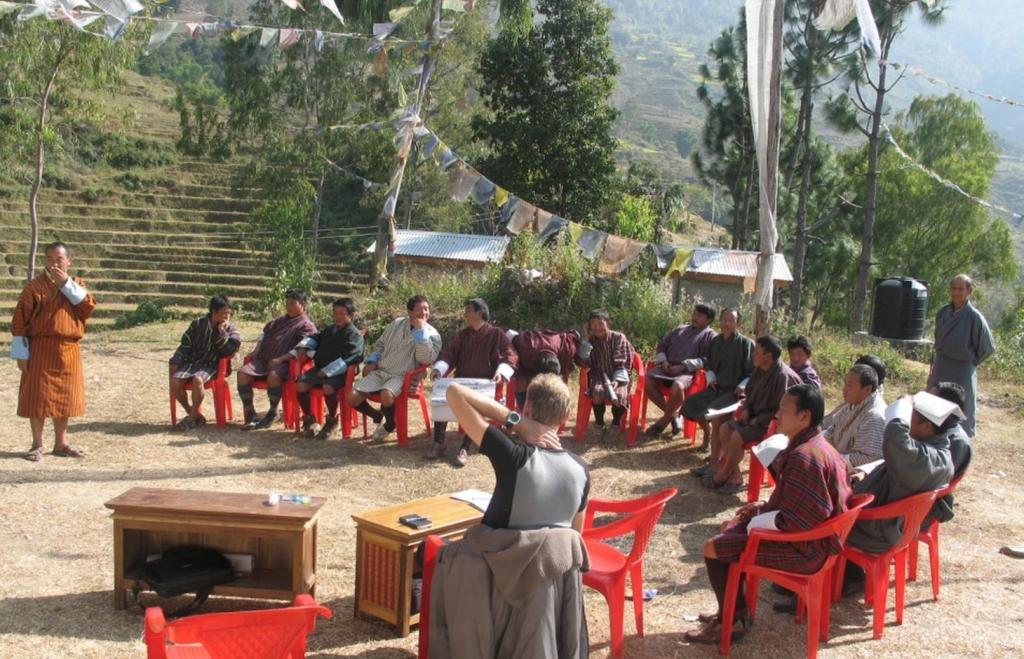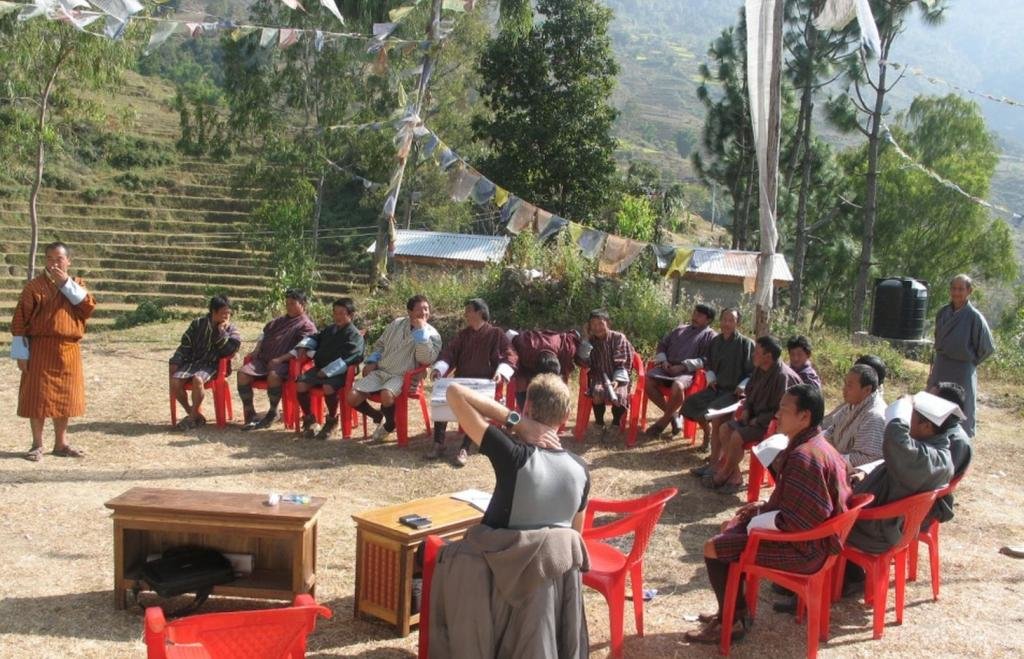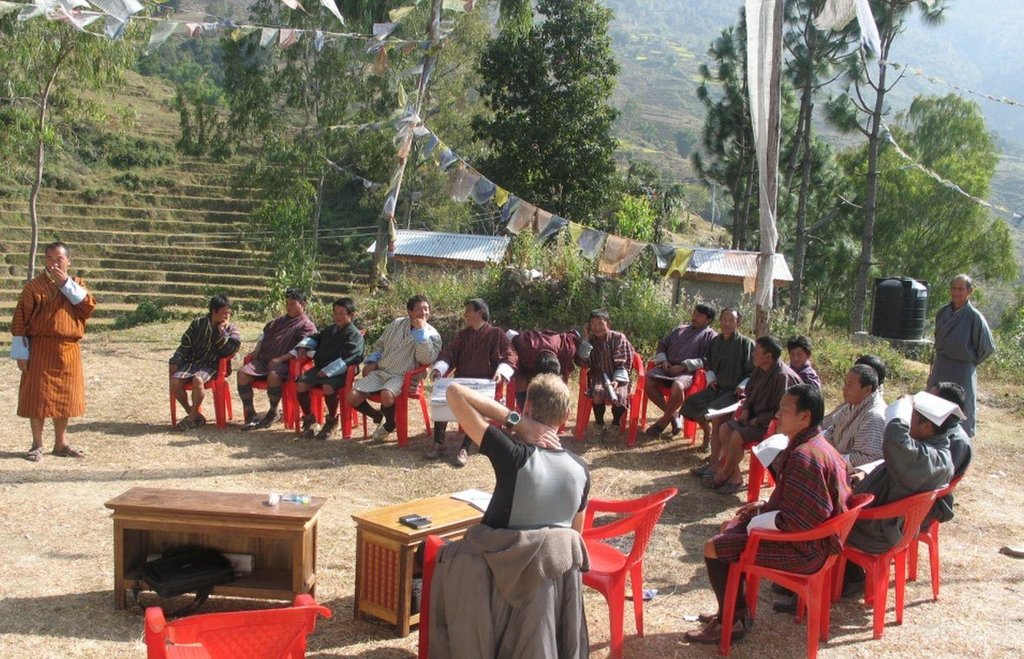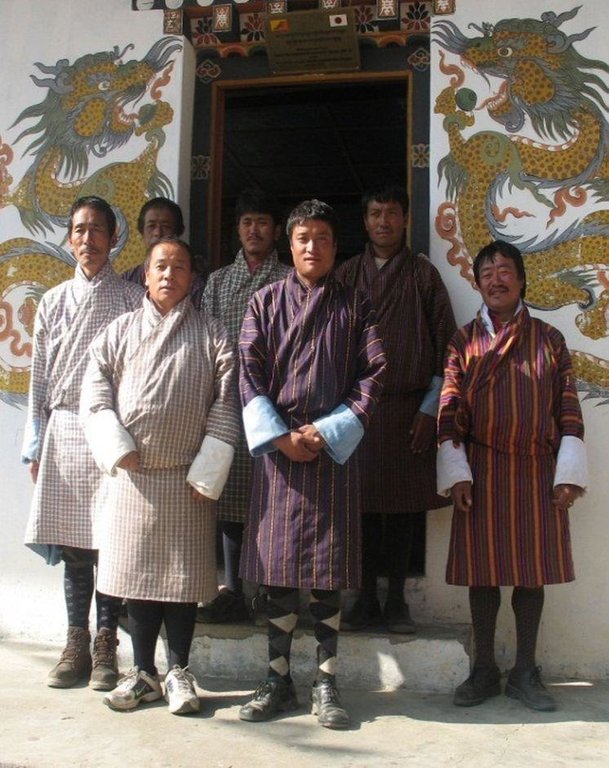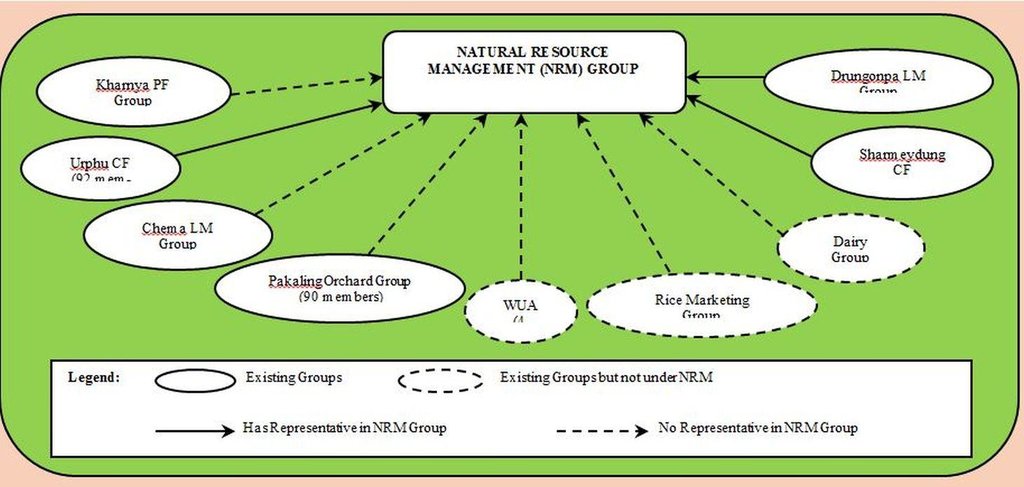Natural Resource Mangement Group [Bhutan]
- Creation:
- Update:
- Compiler: Karma Dorji
- Editor: –
- Reviewer: Fabian Ottiger
Rangzhing Nitang Sunchop Tshogpa (Dzongkha)
approaches_2492 - Bhutan
View sections
Expand all Collapse all1. General information
1.2 Contact details of resource persons and institutions involved in the assessment and documentation of the Approach
Name of the institution(s) which facilitated the documentation/ evaluation of the Approach (if relevant)
MoA (MoA) - BhutanName of the institution(s) which facilitated the documentation/ evaluation of the Approach (if relevant)
National Soil Services Centre (National Soil Services Centre) - Bhutan1.3 Conditions regarding the use of data documented through WOCAT
When were the data compiled (in the field)?
23/03/2011
The compiler and key resource person(s) accept the conditions regarding the use of data documented through WOCAT:
Yes
2. Description of the SLM Approach
2.1 Short description of the Approach
Natural Resource Management Group consisting of village representatives to advocate, plan and implement SLM activities at geog level
2.2 Detailed description of the Approach
Detailed description of the Approach:
Aims / objectives: The Natural Resource Management (NRM) Group was formally established in Radhi geog in 2000 with representatives from all 20 chiogs of the geog. The main tasks of the group are to :1)mobilise local communities in rehabilitating and protecting natural resources from further degradation and 2) to support geog administration, RNR staff and other agencies in planning, implementing and monitoring sustainable natural resource management activities. Radhi geog in Trashigang Dzongkhag, East-Bhutan, has been confronted with severe land degradation as a result of unsustainable land management practices, such as deforestation, overgrazing and poor irrigation water management. The land degradation processes are related to high population pressure and a series of conflicts between chiogs and with neighbouring geogs about use and access to natural resources. Various stakeholders, engaged with reduction and mitigation of land degradation in Radhi, felt the need for a local institution, which should play a pivotal role in advocacy of sustainable management of natural resources. The group was also intended to assist in implementing remedial and preventive measures at village level.
Methods: The NRM group fulfilled a key role in the afforestation program for the Radhi wa-tershed, in particular the very active Chongdiri ravine, which has caused wide-spread loss of arable land and forced resettlement of households, because of a very active landslide area. The chiog representatives, united in the NRM group, mobilized villagers to actively participate in the afforestation and fencing of the buffer zone. This zone was created to arrest the critical land degradation and change unsustainable land management practices, such as free grazing cattle and irrigated paddy cultivation in an active mass movement area.
Seed money was provided to establish a group fund to provide small-scale loans to households for agricultural inputs in order to overcome existing credit access constraints. The intention was to enhance the viability and sustainability of the NRM Group.
Stages of implementation: Over the last 5 years approximately 250 loans have been disbursed of about US$60 each. The NRM group has a loose umbrella function at geog level over a number of sub-groups at chiog level, related to private forestry, community forestry, bamboo and rice marketing, water user associations and land man-agement. The present group structure needs to be reviewed to adapt to the large number of emerging sub-groups.
2.3 Photos of the Approach
2.5 Country/ region/ locations where the Approach has been applied
Country:
Bhutan
Further specification of location:
Trashigang Dzongkhag, Radhi geog
2.6 Dates of initiation and termination of the Approach
Indicate year of initiation:
2000
Year of termination (if Approach is no longer applied):
2012
2.7 Type of Approach
- project/ programme based
2.8 Main aims/ objectives of the Approach
The Approach focused mainly on SLM with other activities (cash-income generation, NRM fund for SLM loans/credit facility)
- The main tasks of the group are to: 1) mobilise local communities in rehabilitating and protecting natural resources from further degradation and 2) to support municipality administration, RNR staff and other agencies in planning, implementing and monitoring sustainable natural resource management activities. A series of government programmes and projects initi-ated activities in Radhi geog and it was decided to create a local institution focused at building capacity in NR management, awareness raising and sensitization.
The SLM Approach addressed the following problems: - Widespread severe land degradation in densely populated area, related to forest degradation, overgrazing, poor irrigation water management, unfavourable geological conditions and NR management conflicts between chiogs and between geogs
2.9 Conditions enabling or hindering implementation of the Technology/ Technologies applied under the Approach
social/ cultural/ religious norms and values
- hindering
Conflicts between geogs (Radhi and Merak) over grazing rights and access, combined with conflicts between chiogs within Radhi over land and water use rights, all contributing to serious land degradation issues in Radhigeog
Treatment through the SLM Approach: Group meetings with chiog representatives; conflict mitigation workshops; formal conflict mitigation and eventually even formal judicial court cases; group formation and support to mitigate land degradation issues and come to consensus
availability/ access to financial resources and services
- hindering
Limited access to agricultural credit facilities
Treatment through the SLM Approach: Establishment of a local NRM group fund
legal framework (land tenure, land and water use rights)
- enabling
The existing land ownership, land use rights / water rights moderately helped the approach implementation: Widespread land tenure facilitates participation level of land users in NRM/SLM activities. Government owned forests have partly been converted to Community Forests, now owned and managed by the local communities. Traditional grazing rights however, have created serious long-lasting inter-geog conflicts that have proved to be difficult to resolve, despite many mediation and judicial efforts.
3. Participation and roles of stakeholders involved
3.1 Stakeholders involved in the Approach and their roles
- local land users/ local communities
NRM group and chiog tshogpas
NRM group is completely male which reflects a local cultural dominance in administrative functions. NRM group provides active support to disadvantaged groups through the NRM group fund, providing access to credit (short-term loans) to enable purchase of seeds/seedlings and other agricultural investments.
- SLM specialists/ agricultural advisers
- national government (planners, decision-makers)
RNR-RC Whengkhar
- international organization
3.2 Involvement of local land users/ local communities in the different phases of the Approach
| Involvement of local land users/ local communities | Specify who was involved and describe activities | |
|---|---|---|
| initiation/ motivation | interactive | Group formation process guided and supported by RNR Research Centres |
| planning | interactive | Since 2006 through participatory SLM action planning in all 20 Radhi villages with support of NRM group representatives |
| implementation | interactive | Group members are actively involved with range of NRM/SLM activities, ranging from irrigation channel renovation, orchard development to bamboo plantation, afforestation and buffer zone creation |
| monitoring/ evaluation | interactive | Combined effort of RNR extension staff, geog administration and NRM group members through participatory M&E meetings to get feedback from villagers and provide a platform for technical guidance to the communities |
| Research | interactive | Initial phase from 2000 to 2006 RNR Research Centres were actively involved in group formation process and capacity building (e.g. bookkeeping training etc.) |
3.3 Flow chart (if available)
Description:
Organisation chart of the NRM group
Author:
Hans van Noord (Schoutenkamp 43 Heteren The Netherlands)
3.4 Decision-making on the selection of SLM Technology/ Technologies
Specify who decided on the selection of the Technology/ Technologies to be implemented:
- mainly land users, supported by SLM specialists
Explain:
Annual SLM Action Planning in all chiogs, supported by NRM group members at chiog level.
Decisions on the method of implementing the SLM Technology were made by mainly by land users supported by SLM specialists. Consultation process in context of annual SLM action planning and participatory M&E meetings.
4. Technical support, capacity building, and knowledge management
4.1 Capacity building/ training
Was training provided to land users/ other stakeholders?
Yes
Specify who was trained:
- land users
- field staff/ advisers
Form of training:
- on-the-job
- farmer-to-farmer
- public meetings
- courses
Form of training:
- study tours
Subjects covered:
NRM group members were actively involved in all NRM/SLM training activities at chiog level, but also took part in training courses aimed at improving their capabilities, such as bookkeeping and fund management. NRM group members took part in national and international study tours on SLM and watershed management and shared their experiences on group formation with other NRM groups. Extension staff received targeted training on NRM conflict management.
4.2 Advisory service
Do land users have access to an advisory service?
Yes
Specify whether advisory service is provided:
- on land users' fields
Describe/ comments:
Name of method used for advisory service: Regular guidance and monitoring for the NRM group; Key elements: Fund management and bookkeeping, Key SLM interventions; Regular guidance and monitoring for the NRM group on group dynamics, group fund management, bookkeeping and training programmes on key SLM interventions.
Advisory service is quite adequate to ensure the continuation of land conservation activities; Good level of awareness and knwoledge of NRM/SLM, proven capacity to manage NRM group fund
4.3 Institution strengthening (organizational development)
Have institutions been established or strengthened through the Approach?
- yes, greatly
Specify the level(s) at which institutions have been strengthened or established:
- local
Specify type of support:
- financial
- capacity building/ training
- equipment
Give further details:
Seed capital for the NRM fund was provided at the start of the NRM group and later provided by SLMP to enable fund growth and provision of more loans. Interest rate charged by the NRM group fund per loan is 12% per annum (to be repaid in one year, otherwise penalty of 3% applies), equal to market rate.
4.4 Monitoring and evaluation
Is monitoring and evaluation part of the Approach?
Yes
Comments:
bio-physical aspects were regular monitored by project staff, land users through observations; indicators: Regular observations by project staff, group members and land users of stability of degraded areas (size, growth, state)
technical aspects were regular monitored by project staff, land users through observations; indicators: Regular observations by project staff, group members and land users of mortality rate of plantations, area of improved dryland, area of orchard development, state and progress of irrigation channel renovation
socio-cultural aspects were regular monitored by project staff, land users through observations; indicators: Regular observations by project staff, group members and land users of inter-chiog and inter-geog conflicts and progress in conflict mitigation
economic / production aspects were regular monitored by project staff, land users through observations; indicators: Regular measurements by project staff, group members and land users in cash income increase and yield change
economic / production aspects were regular monitored by project staff, land users through measurements; indicators: Regular measurement by project staff, group members and land users of area converted to SLM practice
area treated aspects were regular monitored by project staff, land users through measurements; indicators: Regular observations by project staff, group members and land users of households participating in NRM/SLM activities and making use of NRM group fund loans
no. of land users involved aspects were regular monitored by project staff, land users through observations; indicators: Regular observations by project staff, group members and land users of performance of NRM group, amongst others in municipality council meetings for transparency
management of Approach aspects were monitored by project staff, land users through observations
There were few changes in the Approach as a result of monitoring and evaluation: Changes were made to the NRM group composition and structure and the task and responsibilities with arrival of new government programmes and projects in the geog. By-laws were drafted and updated after involvement of SLMP project in 2006 and NRM group fund expanded, with additional seed money for the group fund.
There were no changes in the Technology as a result of monitoring and evaluation
4.5 Research
Was research part of the Approach?
Yes
Specify topics:
- sociology
Give further details and indicate who did the research:
Research was actively involved in the initial stages of the NRM group establishment, with special attention to the conflicts between Radhi and Merakgeogs on grazing land (double grazing as result of winter grazing for semi-nomadic yak herders and summer grazing for cattle from lower altitudes, resulting in severe land degradation).
Research was carried out on-farm
5. Financing and external material support
5.1 Annual budget for the SLM component of the Approach
If precise annual budget is not known, indicate range:
- 2,000-10,000
Comments (e.g. main sources of funding/ major donors):
Approach costs were met by the following donors: international (Seed funding, SLMP contributions): 80.0%; local government (district, county, municipality, village etc) (local community and geog administration (including RNR extension staff)): 15.0%; local community / land user(s) (membership contributions): 5.0%
5.2 Financial/ material support provided to land users
Did land users receive financial/ material support for implementing the Technology/ Technologies?
Yes
5.3 Subsidies for specific inputs (including labour)
- equipment
| Specify which inputs were subsidised | To which extent | Specify subsidies |
|---|---|---|
| Office equipment | fully financed | |
If labour by land users was a substantial input, was it:
- voluntary
Comments:
Most of the labour was provided voluntary by group members and the related communities they represent. Especially the buffer zone creation around the severely degraded Chongdiri ravine and related afforestation and fencing activities required substantial labour inputs. Some other afforestation labour was partly subsidized.
The NRM group was supported with office equipment and computer/printer to enable proper administration and bookkeeping.
5.4 Credit
Was credit provided under the Approach for SLM activities?
Yes
Specify conditions (interest rate, payback, etc.):
Interest rate charged: 12.0%; repayment conditions: Within one year repayment, otherwise penalty with 3%.
Interest was equal to market rate.
Specify credit receivers:
BDFC
6. Impact analysis and concluding statements
6.1 Impacts of the Approach
Did the Approach help land users to implement and maintain SLM Technologies?
- No
- Yes, little
- Yes, moderately
- Yes, greatly
Great improvement has been recorded over the last decade of NRM group involvement through improved vegetation cover (afforestation of “green belt”, buffer zone creation and afforestation), stabilization of degraded areas, improved irrigation water management, bamboo plantation and raised capacity of land users in SLM/NRM.
Did the Approach empower socially and economically disadvantaged groups?
- No
- Yes, little
- Yes, moderately
- Yes, greatly
NRM group advocates inclusive approach and issues loans for agricultural inputs to vulnerable families that otherwise would have poor access to credit facilities.
Did the Approach improve issues of land tenure/ user rights that hindered implementation of SLM Technologies?
- No
- Yes, little
- Yes, moderately
- Yes, greatly
Traditional grazing rights however, have created serious long-lasting inter-geog conflicts that have proved to be difficult to resolve, despite many mediation and judicial efforts.
Did other land users / projects adopt the Approach?
- No
- Yes, little
- Yes, moderately
- Yes, greatly
NRM group has become focal institution within the geog for any activity related to NRM/SLM and government institutions keenly collaborate with the group.
Did the Approach lead to improved livelihoods / human well-being?
- No
- Yes, little
- Yes, moderately
- Yes, greatly
Stabilization of degraded areas and afforestation efforts have contributed to improved well-being and security; additionally cash-income generation has been markedly improved through a series of NRM/SLM activities (bamboo marketing, orchard development, vegetable production, irrigation channel improvement etc.).
Did the Approach help to alleviate poverty?
- No
- Yes, little
- Yes, moderately
- Yes, greatly
The overall advocacy and implementation support of the RNM group to NRM/SLM activities have enhanced the cash-generating opportunities of all households and this is facilitated by the access to the NRM group funds for loans for agricultural inputs, often a great constraint for the most vulnerable households.
6.2 Main motivation of land users to implement SLM
- payments/ subsidies
- environmental consciousness
6.3 Sustainability of Approach activities
Can the land users sustain what has been implemented through the Approach (without external support)?
- yes
If yes, describe how:
Determination of NRM group to continue is based on almost 10 years of experience and perceived benefits of the NRM group structure. The proven management capabilities of the NRM group fund are a mechanism to support NRM/SLM activities of local households and will facilitate the financial sustainability of the NRM group itself.
6.4 Strengths/ advantages of the Approach
| Strengths/ advantages/ opportunities in the land user’s view |
|---|
|
Increased awareness of budgets related to SLM Better dealing with community through specific trainings Improved planning capacity Better knwoledge of specific SLM interventions (how, where, what, when) Exposure to study tours as NRM group member (How to sustain/ enhance this strength: Continued support to NRM group idem idem idem idem) |
| Strengths/ advantages/ opportunities in the compiler’s or other key resource person’s view |
|---|
|
Strengthened local institution focused on NRM/SLM eases advocacy, planning and implementation of field-level activities Facilitates access to local credit through NRM group fund for agricultural inputs linked to NRM/SLM Enhances sustainability of SLM activities and local capacity in the municipality after project period ends (How to sustain/ enhance this strength: Continued support to NRM group Continued support to NRM group in group fund management/auditing/transparency Continued support to NRM group) |
6.5 Weaknesses/ disadvantages of the Approach and ways of overcoming them
| Weaknesses/ disadvantages/ risks in the land user’s view | How can they be overcome? |
|---|---|
|
Lack of understanding by community members of role and objectives of NRM group and its members Time-consuming for NRM group members, especially in peak agricultural season as many NRM/SLM activities need to be supported Some difficulties in targeting vulnerable households (lack of understanding, feeling of enforcement/being compelled) |
Better communication and support by municipality administration Provide adequate support by local RNR extension team Provide adequate support by local RNR extension team |
| Weaknesses/ disadvantages/ risks in the compiler’s or other key resource person’s view | How can they be overcome? |
|---|---|
|
Relation to many other village groups related to NRM/SLM need to be improved/simplified to create a more transparent structure |
Review of representation of key sub-groups in NRM group |
7. References and links
7.1 Methods/ sources of information
- field visits, field surveys
- interviews with land users
Links and modules
Expand all Collapse allLinks
No links
Modules
No modules


